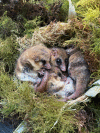The ecology and evolution of the monito del monte, a relict species from the southern South America temperate forests
- PMID: 35261741
- PMCID: PMC8888251
- DOI: 10.1002/ece3.8645
The ecology and evolution of the monito del monte, a relict species from the southern South America temperate forests
Abstract
The arboreal marsupial monito del monte (genus Dromiciops, with two recognized species) is a paradigmatic mammal. It is the sole living representative of the order Microbiotheria, the ancestor lineage of Australian marsupials. Also, this marsupial is the unique frugivorous mammal in the temperate rainforest, being the main seed disperser of several endemic plants of this ecosystem, thus acting as keystone species. Dromiciops is also one of the few hibernating mammals in South America, spending half of the year in a physiological dormancy where metabolism is reduced to 10% of normal levels. This capacity to reduce energy expenditure in winter contrasts with the enormous energy turnover rate they experience in spring and summer. The unique life history strategies of this living Microbiotheria, characterized by an alternation of life in the slow and fast lanes, putatively represent ancestral traits that permitted these cold-adapted mammals to survive in this environment. Here, we describe the ecological role of this emblematic marsupial, summarizing the ecophysiology of hibernation and sociality, updated phylogeographic relationships, reproductive cycle, trophic relationships, mutualisms, conservation, and threats. This marsupial shows high densities, despite presenting slow reproductive rates, a paradox explained by the unique characteristics of its three-dimensional habitat. We finally suggest immediate actions to protect these species that may be threatened in the near future due to habitat destruction and climate change.
Keywords: Australidelphia; climate change; conservation; hibernation; marsupial; seed dispersal.
© 2022 The Authors. Ecology and Evolution published by John Wiley & Sons Ltd.
Conflict of interest statement
The authors have no conflicts of interest to declare.
Figures








Similar articles
-
The biogeography of Dromiciops in southern South America: Middle Miocene transgressions, speciation and associations with Nothofagus.Mol Phylogenet Evol. 2021 Oct;163:107234. doi: 10.1016/j.ympev.2021.107234. Epub 2021 Jun 17. Mol Phylogenet Evol. 2021. PMID: 34146676
-
Morphology and evolution of the oral shield in marsupial neonates including the newborn monito del monte (Dromiciops gliroides, Marsupialia Microbiotheria) pouch young.J Anat. 2017 Jul;231(1):59-83. doi: 10.1111/joa.12621. J Anat. 2017. PMID: 28620997 Free PMC article.
-
Bioenergetics and inter-individual variation in physiological capacities in a relict mammal - the Monito del Monte (Dromiciops gliroides).J Exp Biol. 2009 Jan;212(Pt 2):297-304. doi: 10.1242/jeb.021212. J Exp Biol. 2009. PMID: 19112149
-
Ecological consistency across space: a synthesis of the ecological aspects of Dromiciops gliroides in Argentina and Chile.Naturwissenschaften. 2012 Nov;99(11):873-81. doi: 10.1007/s00114-012-0969-2. Epub 2012 Sep 21. Naturwissenschaften. 2012. PMID: 22996392 Review.
-
Status and challenges for conservation of small mammal assemblages in South America.Biol Rev Camb Philos Soc. 2014 Aug;89(3):705-22. doi: 10.1111/brv.12080. Epub 2014 Jan 23. Biol Rev Camb Philos Soc. 2014. PMID: 24450972 Review.
Cited by
-
Climate change and population persistence in a hibernating marsupial.Proc Biol Sci. 2024 Jun;291(2025):20240266. doi: 10.1098/rspb.2024.0266. Epub 2024 Jun 26. Proc Biol Sci. 2024. PMID: 38920109 Free PMC article.
-
Local adaptation of Dromiciops marsupials (Microbiotheriidae) from southern South America: Implications for species management facing climate change.Ecol Evol. 2024 Oct 3;14(10):e70355. doi: 10.1002/ece3.70355. eCollection 2024 Oct. Ecol Evol. 2024. PMID: 39371267 Free PMC article.
-
Communal nesting is the optimal strategy for heat conservation in a social marsupial: lessons from biophysical models.J Exp Biol. 2022 Nov 15;225(22):jeb244606. doi: 10.1242/jeb.244606. Epub 2022 Nov 25. J Exp Biol. 2022. PMID: 36420835 Free PMC article.
-
Telomere dynamics during hibernation in a tropical primate.J Comp Physiol B. 2024 Apr;194(2):213-219. doi: 10.1007/s00360-024-01541-9. Epub 2024 Mar 11. J Comp Physiol B. 2024. PMID: 38466418
-
Modeling heterothermic fitness landscapes in a marsupial hibernator using changes in body composition.Oecologia. 2023 Oct;203(1-2):79-93. doi: 10.1007/s00442-023-05452-4. Epub 2023 Oct 5. Oecologia. 2023. PMID: 37798536 Free PMC article.
References
-
- Aizen, M. A. (2003). Influences of animal pollination and seed dispersal on winter flowering in a temperate mistletoe. Ecology, 84(10), 2613–2627. 10.1890/02-0521 - DOI
-
- Amico, G. C. , Rodríguez‐Cabal, M. A. , & Aizen, M. A. (2009). The potential key seed‐dispersing role of the arboreal marsupial Dromiciops gliroides . Acta Oecologica‐International Journal of Ecology, 35(1), 8–13. 10.1016/j.actao.2008.07.003 - DOI
-
- Amico, G. C. , Rodríguez‐Cabal, M. A. , & Aizen, M. A. (2011). Geographic variation in fruit colour is associated with contrasting seed disperser assemblages in a south‐Andean mistletoe. Ecography, 34(2), 318–326. 10.1111/j.1600-0587.2010.06459.x - DOI
-
- Amico, G. C. , Sasal, Y. , Vidal‐Russell, R. , Aizen, M. A. , & Morales, J. M. (2017). Consequences of disperser behaviour for seedling establishment of a mistletoe species. Austral Ecology, 42(8), 900–907. 10.1111/aec.12517 - DOI
Publication types
LinkOut - more resources
Full Text Sources

